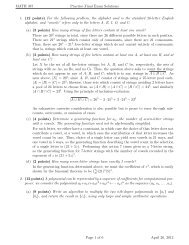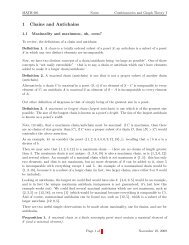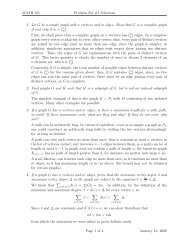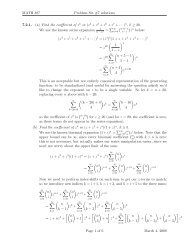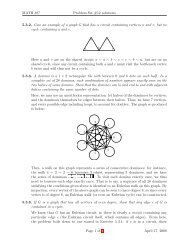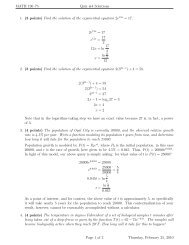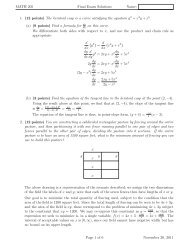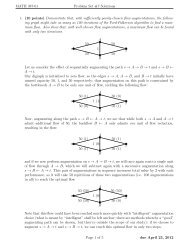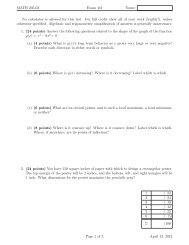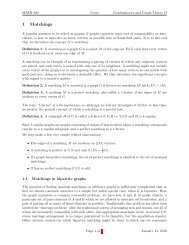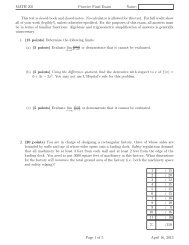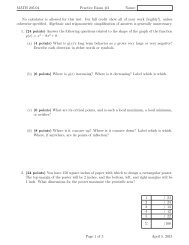MATH 205â04 Quiz #2 Solutions 1. (6 points) Prove that lim 5 - 3x ...
MATH 205â04 Quiz #2 Solutions 1. (6 points) Prove that lim 5 - 3x ...
MATH 205â04 Quiz #2 Solutions 1. (6 points) Prove that lim 5 - 3x ...
You also want an ePaper? Increase the reach of your titles
YUMPU automatically turns print PDFs into web optimized ePapers that Google loves.
<strong>MATH</strong> 205–04<br />
<strong>Quiz</strong> <strong>#2</strong> <strong>Solutions</strong><br />
<strong>1.</strong> (6 <strong>points</strong>) <strong>Prove</strong> <strong>that</strong> <strong>lim</strong><br />
x→2<br />
5 − <strong>3x</strong> = −1 by finding a satisfactory relationship between epsilon<br />
and delta.<br />
The statement <strong>lim</strong> x→2 5 − <strong>3x</strong> = −1 is an assertion <strong>that</strong>, for every value ɛ > 0, a value δ can be<br />
furnished such <strong>that</strong>, if 0 < |x − 2| < δ, then |5 − <strong>3x</strong> − (−1)| < ɛ. We may justify this assertion<br />
by explicity determining how δ is calculated from ɛ to make this inference true.<br />
|5 − <strong>3x</strong> − (−1)| < ɛ<br />
|6 − <strong>3x</strong>| < ɛ<br />
| − 3(x − 2)| < ɛ<br />
| − 3| · |x − 2| < ɛ<br />
3|x − 2| < ɛ<br />
|x − 2| < ɛ 3<br />
so we may declare <strong>that</strong> the choice of δ equal to ɛ 3<br />
are given.<br />
is sufficient to meet whatever challenge we<br />
2. (4 <strong>points</strong>) Find a value for the parameter a such <strong>that</strong> the function f(x) =<br />
continuous everywhere.<br />
{<br />
5 − x if x ≤ 2<br />
ax 2 if x > 2 is<br />
The expressions 5 − x and ax 2 are themselves both continuous on their domain, so the only<br />
potential problem is <strong>that</strong> the piecewise function may not be continuous at the point where it<br />
transitions between these two behaviors; thus we need simply to ensure continuity at the point<br />
x = 2:<br />
<strong>lim</strong><br />
x→2<br />
x→2<br />
f(x) = <strong>lim</strong> f(x) = f(2)<br />
− +<br />
5 − 2 = a · 2 2 = 5 − 2<br />
3 = 4a<br />
3<br />
4 = a<br />
2−x<br />
3. (4 <strong>points</strong>) Calculate the value of <strong>lim</strong><br />
3<br />
, or explicitly indicate <strong>that</strong> it does not exist.<br />
x→−∞ 7x 4 −9x 2<br />
We can look at the dominant term in the numerator and denominator, and conclude <strong>that</strong> for<br />
2−x<br />
x of very large magnitude, 3<br />
≈ −x3 , so <strong>that</strong><br />
7x 4 −9x 2 7x 4<br />
<strong>lim</strong><br />
x→−∞<br />
2 − x 3<br />
7x 4 − 9x 2 =<br />
<strong>lim</strong> −x 3<br />
x→+∞ 7x = <strong>lim</strong> −1<br />
4 x→+∞ 7x = 0<br />
or, alternatively, we could divide the numerator and denominator by x 4 to get:<br />
<strong>lim</strong><br />
x→+∞<br />
2 − x 3<br />
7x 4 − 9x 2 =<br />
<strong>lim</strong><br />
x→+∞<br />
2−x 3<br />
x 4<br />
7x 4 −9x 2<br />
x 4 = <strong>lim</strong><br />
x→+∞<br />
2<br />
x 4 − 1 x<br />
7 − 9 x 2 = 0 − 0<br />
7 − 0 = 0.<br />
Page 1 of 2 Friday, February 1, 2013
<strong>MATH</strong> 205–04<br />
<strong>Quiz</strong> <strong>#2</strong> <strong>Solutions</strong><br />
4. (6 <strong>points</strong>) Let f(x) = 2x 2 − <strong>3x</strong>. Using the difference quotient, calculate the derivative f ′ (2).<br />
f ′ (2) = <strong>lim</strong><br />
h→0<br />
f(2 + h) − f(2)<br />
h<br />
= <strong>lim</strong><br />
h→0<br />
[2(2 + h) 2 − 3(2 + h)] − (2 · 2 2 − 3 · 2)<br />
h<br />
= <strong>lim</strong><br />
h→0<br />
(2 · 2 2 + 8h + h 2 − 3 · 2 − 3h) − (2 · 2 2 − 3 · 2)<br />
h<br />
= <strong>lim</strong><br />
h→0<br />
8h + h 2 − 3h<br />
h<br />
= <strong>lim</strong><br />
h→0<br />
8 + h − 3 = 5<br />
5. (2 point bonus) Use epsilon-delta methods (or an appropriate analogue thereof) to prove, on<br />
x<br />
the back of this sheet, <strong>that</strong> <strong>lim</strong><br />
2 −2x<br />
= +∞.<br />
x→3 + 2x−6<br />
The statement <strong>lim</strong> x→3 + x2 −2x<br />
2x−6<br />
furnished such <strong>that</strong>, if 3 < x < 3+δ, then x2 −2x<br />
= +∞ is an assertion <strong>that</strong>, for every value E, a value δ can be<br />
2x−6<br />
determining how δ is calculated from E to make this inference true.<br />
> E. We may justify this assertion by explicity<br />
x 2 − 2x<br />
2x − 6 > E<br />
x 2 − 2x > (2x − 6)E if x > 3<br />
x 2 − (2 + 2E)x + 6E > 0 if x > 3<br />
x < 2 + 2E − √ (2 + 2E) 2 − 24E<br />
2<br />
= 1 + E − √ (1 + E) 2 − 6E suffices<br />
So we note <strong>that</strong> δ = 1 + E − √ (1 + E) 2 − 6E − 3 is sufficient; it’s a bit fiddly to show <strong>that</strong> this<br />
quantity is in fact positive, though:<br />
(E − 2) 2 = E 2 − 4E + 4<br />
(E − 2) 2 > E 2 − 4E + 1<br />
(1 + E − 3) 2 > E 2 + 2E + 1 − 6E<br />
(1 + E − 3) 2 > (1 + E) 2 − 6E<br />
δ = 1 + E − √ (1 + E) 2 − 6E − 3 > 0<br />
1 + E − 3 > √ (1 + E) 2 − 6E<br />
Page 2 of 2 Friday, February 1, 2013




